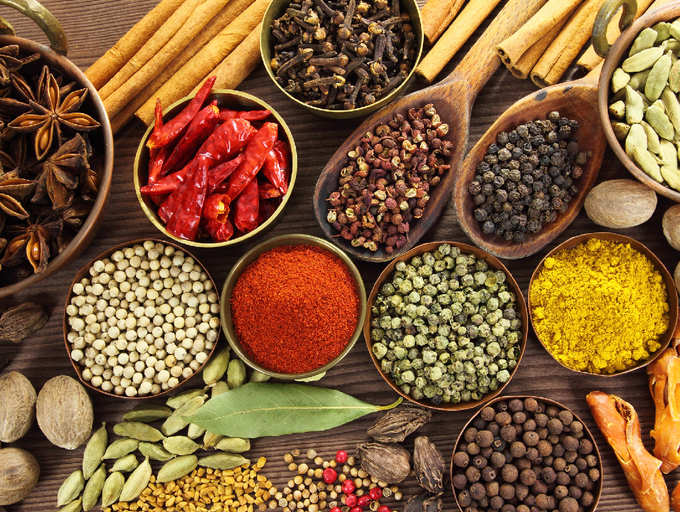- ART
- 5 min read
An Ayurvedic Expedition: The Wonders of Popular Spices
OJC
21st Nov 2023
An Ayurvedic Expedition: The Wonders of Popular Spices
Posted by Mercie Migadde November 4th, 2023
Introduction
In this blog, we embark on a fascinating journey to explore the most popular spices used in cooking and Ayurveda, delving into their unique characteristics, culinary applications, and the remarkable health benefits they offer.
Turmeric: The Golden Spice of Life
Turmeric, the queen of spices, reigns supreme in both the kitchen and the Ayurvedic apothecary. Its vibrant yellow hue, derived from the curcuminoid curcumin, lends warmth and depth to culinary creations, while its array of health benefits has earned it a revered position in Ayurvedic healing.
Curcumin, the active compound in turmeric, possesses potent anti-inflammatory and antioxidant properties, making it a valuable tool in combating various ailments. Studies have shown its effectiveness in reducing chronic inflammation, alleviating joint pain, and potentially protecting against neurodegenerative diseases and certain types of cancer.
In the kitchen, turmeric lends its golden touch to a myriad of dishes, from curries and stews to rice and golden milk. Its earthy flavor and aroma harmonize beautifully with other spices, adding complexity and depth to culinary creations.
Cumin: The Aromatic Spice that Warms the Soul
Cumin, with its warm, earthy aroma and slightly bitter-sweet flavor, is a staple in cuisines worldwide. It is a key ingredient in curries, chili powders, and spice blends, adding depth and complexity to savory dishes.
In Ayurveda, cumin is valued for its digestive properties. It is believed to stimulate the production of digestive enzymes, aiding in the breakdown of food and promoting nutrient absorption. Additionally, cumin is considered a warming spice, helping to balance Kapha dosha, the Ayurvedic principle associated with heaviness and lethargy.
In the kitchen, cumin's versatility shines through. It is a crucial ingredient in Indian cuisine, where it forms the base of garam masala and adds depth to curries, dals, and vegetable dishes. Its warm aroma and slightly bitter-sweet flavor also complement Mexican and Middle Eastern cuisine, enhancing the flavors of chili powder, taco seasoning, and hummus.
Coriander: The Cooling Spice that Soothes the Body
Coriander, with its citrusy-sweet aroma and slightly nutty flavor, is a ubiquitous spice in global cuisines. Its versatility extends from savory dishes to sweet treats, adding a refreshing touch and balancing out bold flavors.
In Ayurveda, coriander is considered a cooling spice, believed to pacify Pitta dosha, the Ayurvedic principle associated with heat and inflammation. It is traditionally used to alleviate digestive issues, promote detoxification, and reduce inflammation.
In the kitchen, coriander's culinary applications are vast. Its fresh leaves are a staple in Asian cuisine, adding a vibrant flavor to salsas, salads, and curries. The dried seeds, ground into coriander powder, are a key ingredient in spice blends, curries, and marinades.
Fennel: The Sweet and Soothing Spice that Tames Digestion
Fennel, a versatile spice with a sweet, licorice-like flavor, holds a unique position in both culinary traditions and Ayurveda. Its delicate aroma and soothing properties make it a welcome addition to both savory dishes and sweet delights.
In Ayurveda, fennel is revered for its digestive properties. It is believed to stimulate the production of digestive enzymes, reduce bloating, and soothe an upset stomach. Additionally, fennel's sweet flavor is thought to balance Vata dosha, the Ayurvedic principle associated with air and movement.
In the kitchen, fennel's versatility shines through. Its fresh fronds add a delicate anise flavor to salads, soups, and fish dishes, while the dried seeds, ground into fennel powder, are a key ingredient in spice blends, sausages, and baked goods.
Cardamom: The Queen of Spices that Enchants the Senses
Cardamom, the "queen of spices," is prized for its complex aroma, combining sweet, citrusy, and woody notes. It is a staple in Indian cuisine, adding a touch of luxury to sweet and savory dishes.
In Ayurveda, cardamom is valued for its digestive and stimulating properties. It is believed to aid in digestion, reduce bloating, and awaken the senses.
Cardamom's versatility shines through in the culinary realm. Its whole pods are employed to infuse flavor into rice, teas, and sweet delicacies, while ground cardamom powder lends a touch of warmth and complexity to curries, pastries, and even coffee.
Conclusion
As we conclude our culinary and Ayurvedic expedition through the world of popular spices, we leave with a profound appreciation for the rich tapestry of flavors, aromas, and healing properties these botanical treasures hold. From the invigorating zest of ginger to the warming embrace of turmeric, each spice unveils a unique symphony of culinary and therapeutic benefits.
Indulge your senses in the culinary artistry of spices, allowing their vibrant flavors and intricate aromas to dance upon your palate. Embrace the ancient wisdom of Ayurveda, harnessing the healing power of spices to nurture your body and restore balance to your well-being.
May this journey inspire you to embark on your own culinary and Ayurvedic adventures, forever cherishing the transformative power of spices in enriching your life with vibrant flavors and holistic wellness.
1 comment(s)
-

century -foods
14th Nov 2024Thanks for sharing this very well-written and worth-reading article. Wish to see more in the coming days.